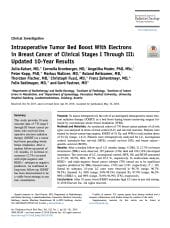Authors
Julia Kaiser, MD, Cornelia Kronberger, MD, Angelika Moder, PhD, MSc, Peter Kopp, PhD, Markus Wallner, MD, Roland Reitsamer, MD, Thorsten Fischer, MD, Christoph Fussl, MD, Franz Zehentmayr, MD, Felix Sedlmayer, MD, and Gerd Fastner, MD
Summary
This study provides 10-year outcome data of 770 stage I through III breast cancer patients who received intraoperative electron radiation therapy (IOERT) as a tumor bed boost preceding whole breast irradiation. After a median follow-up period of 121 months, 21 in-breast recurrences (2.7%) occurred with triple-negative and HER2fl subtypes as negative predictors. As confirmed in long-term follow-up, IOERT has been demonstrated to be a viable boost strategy in any risk constellation.
Purpose
To assess retrospectively the role of an anticipated intraoperative tumor electron radiation therapy (IOERT) as a bed boost during breast-conserving surgery followed by conventional whole breast irradiation (WBI).
Method and Materials
An unselected cohort of 770 breast cancer patients of all risk types was analyzed in terms of local control (LC) and survival outcome. Patients were treated by breast-conserving surgery, IOERT of 10 Gy, and WBI to total median doses of 54 Gy (range, 1.6-2). Patients were retrospectively analyzed for LC, locoregional control, metastasis-free survival (MFS), overall survival (OS), and breast cancer-specific survival (BCSS).
Results
After a median follow-up of 121 months (range, 4-200), 21 (2.7%) in-breast recurrences (IBRs) were observed, 107 patients (14%) died and 106 (14%) developed metastases. Ten-year rates of LC, locoregional control, MFS, OS, and BCSS amounted to 97.2%, 96.5%, 86%, 85.7%, and 93.2 %, respectively. In multivariate analysis, HER2fl and triple-negative breast cancer subtype (TN) turned out to be significant negative predictors for IBRs (hazard ratios, 15.02 and 12.87, respectively; P < .05). Sorted by subtypes, 10-year LC rates were observed in 98.7% (range, 96.7%- 99.5%) (luminal A), 98% (range, 94%-99.3%) (luminal B), 87.9% (range, 66.2%- 96%) (HER2fl ), and 89% (range, 76.9%-94.9%) (TN), respectively.
Conclusions
After 10 years, boost IOERT maintains high LC rates in any risk setting.
